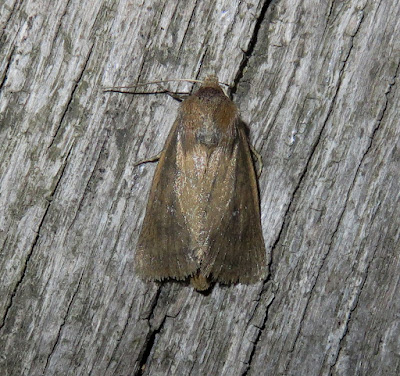Dave Grundy travelled from the Midlands to carry out some moth-trapping ahead of a couple of moth identification courses he was running locally. The five traps he placed on or close to the beach at the park on Thursday 11th, here pictured just after dawn the next day. Three more traps were also operating back in the car park area.
The second visit was on the Monday 15th when six traps were dotted along the park seawall, beach and here in the picture on the cliff-top. I had three traps going in the car park that same night.
Conditions on the second night weren't as good for moths with a clear sky leading to a heavy dew by dawn.
Conditions on the second night weren't as good for moths with a clear sky leading to a heavy dew by dawn.
The only pine hawkmoth of the summer at the park made an appearance on the 11th, this one looking a little bit worn. A poplar hawkmoth was found down on the grass covered in dew at dawn on the 16th.
There was a good showing of archer's darts from the traps along the seawall with about eight individuals noted - the most seen in one night here.
Amongst several orange swifts were a couple of very strikingly coloured purple females, one shown here.
The dark spinach was in a trap by the beach and I think the first record for the site, probably being overlooked in the past. It's a widespread moth generally and has the foodplants of orache and goosefoot here by the beach.
Other moths of note were several sandhill rustics, ground lackey, white-line dart, white-points, tree-lichen beauty, maple prominent, silver-Y, saltmarsh plume, Webb's wainscot and twin-spotted wainscot.
The three traps in the car park caught 46 species of macro over the two nights.
Other moths of note were several sandhill rustics, ground lackey, white-line dart, white-points, tree-lichen beauty, maple prominent, silver-Y, saltmarsh plume, Webb's wainscot and twin-spotted wainscot.
The three traps in the car park caught 46 species of macro over the two nights.
At and earlier mothing session at the park on Monday 8th, this poplar kitten was one of the less regular moths noted that night. On a clear but breezy night 53 species were noted.
A sharp-angled peacock was also noted at the park on the 8th.
Also noted were lackey, drinker, pebble hook-tip, maidens blush, least carpet, red twin-spot carpet, yellow-barred brindle, poplar hawkmoth, pebble prominent, ruby tiger, nutmeg, lychnis, white-point, poplar grey, sandhill rustic and flounced rustic.
Also noted were lackey, drinker, pebble hook-tip, maidens blush, least carpet, red twin-spot carpet, yellow-barred brindle, poplar hawkmoth, pebble prominent, ruby tiger, nutmeg, lychnis, white-point, poplar grey, sandhill rustic and flounced rustic.
An evening of moth-trapping in the Firs Chase garden on Saturday 13th was quite rewarding on a partially clear night. Thirty-two species of macro of just over 100 individuals were recorded.
This twin-spotted wainscot pictured above, was the most notable being an Essex Red data book species.
The pretty marbled beauty was found at the Firs Chase trap, a common moth it has been noted here before.
This common blood-vein moth caught the eye with the pretty pink border along the wings.
Other moths noted in Firs Chase included oak hook-tip, single dotted wave, garden carpet, cypress pug, coronet, copper underwing, sandhill rustic, silver-Y, herald and rosy rustic.












No comments:
Post a Comment